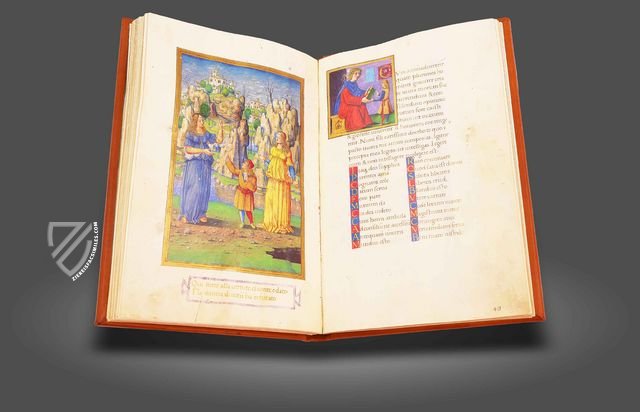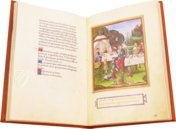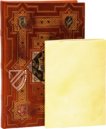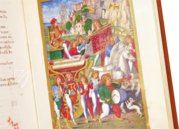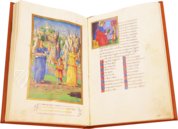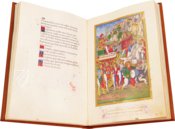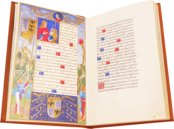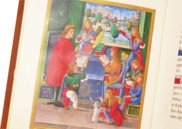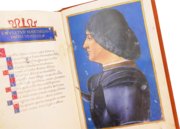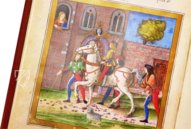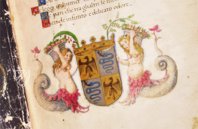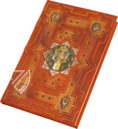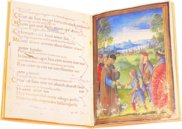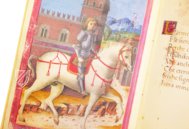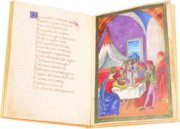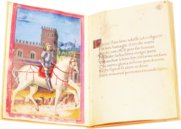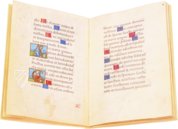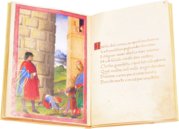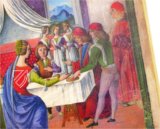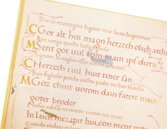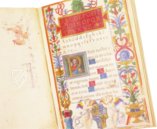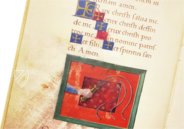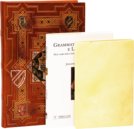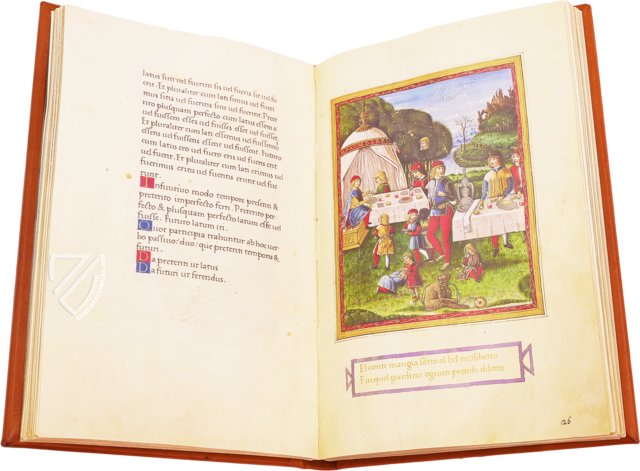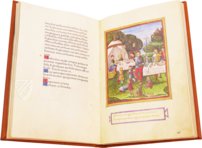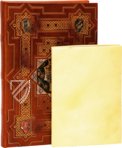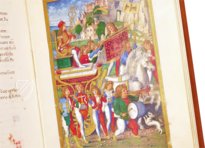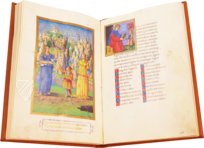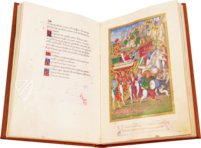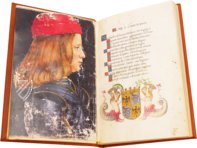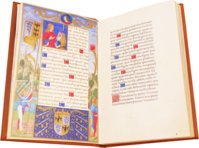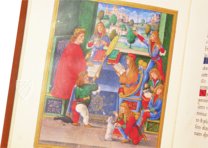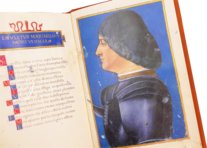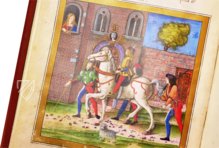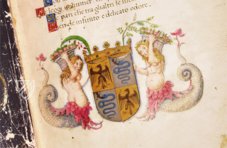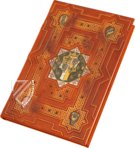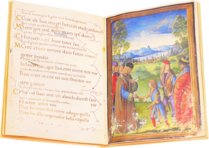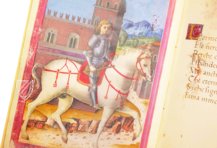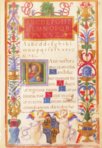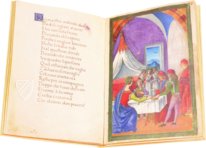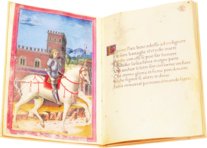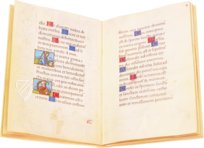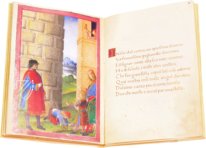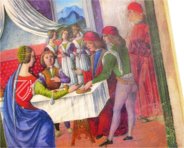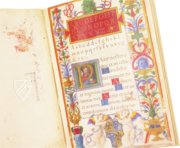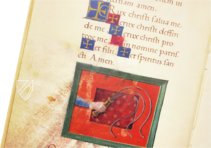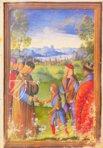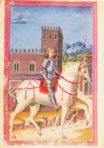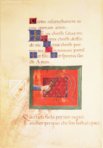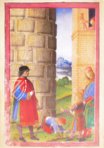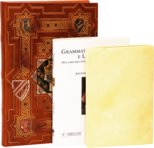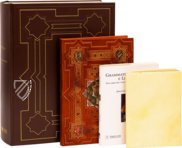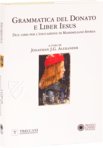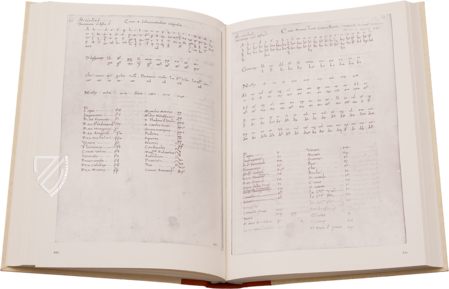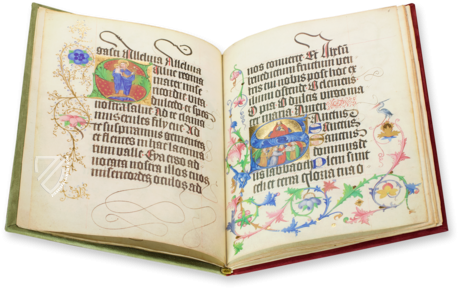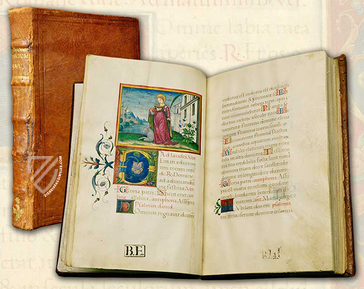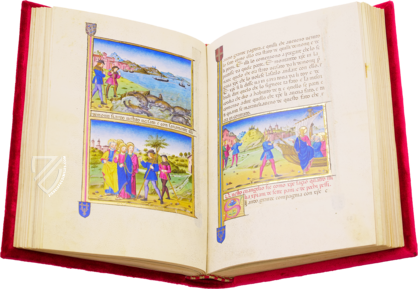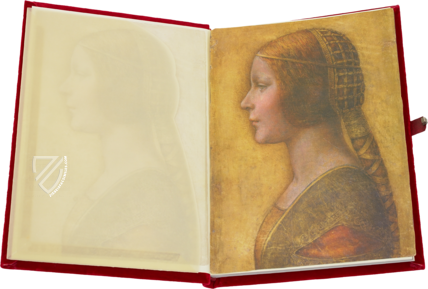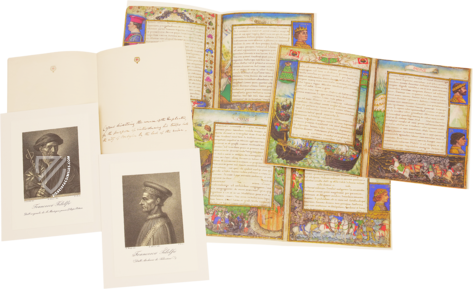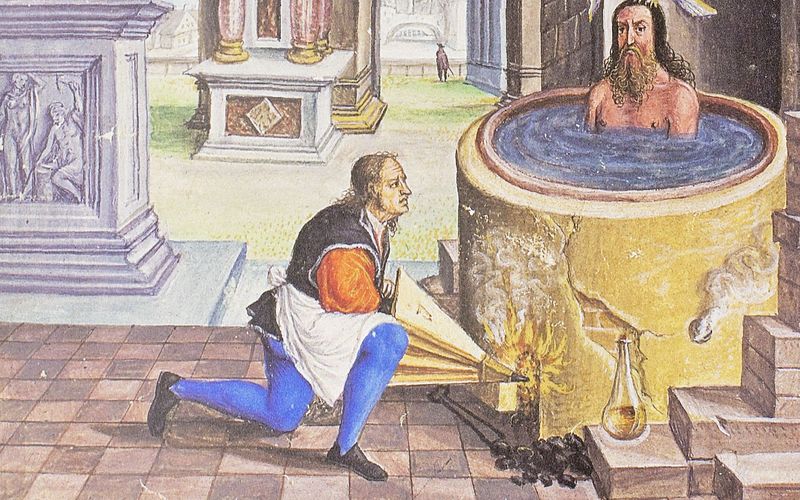Liber Iesus and Treatise on Grammar by Donatus
The so-called Grammatica Sforza is a special primer that was beautifully illuminated for Maximilian Sforza (1493–1530), the eldest son of the Duke of Milan, Ludovico il Moro (1452–1508). Designed as an anthology, the manuscript combines an adaptation of Aelius Donatus' (c. 310 – c. 380) handbook of Latin grammar with moral and didactic treatises, poems, and prayers. Although the texts, which often draw on ancient works, are primarily in Latin, there are also sections in Italian and German. They are all illuminated by 11 full-page miniatures in gold frames, including fascinating profile portraits of Maximilian and his father. The opulent illumination makes the codex one of the most magnificent examples of a Latin textbook produced during the Italian Early Renaissance. At the same time, the primer is an artistic testimony to the emerging humanism that revived late antique moral concepts through works such as this.
Liber Iesus and Treatise on Grammar by Donatus
Illuminated primers intended for the education of children are among the rarest manuscripts produced during the Middle Ages. This primer was commissioned by the Duke of Milan, Ludovico il Moro (1452–1508), for his eldest son Maximilian Sforza (1493–1530) and features numerous splendid portraits of the Italian princeling. The text consists primarily of two parts, the Liber Iesus and the Grammatica del Donato, an anonymous adaptation of the Ars grammatica by Aelius Donatus, a Roman grammarian and teacher of rhetoric active in the mid-4th century and tutor of Saint Jerome (347-420). The work by Donatus belongs to the literary genre of the Ianuae and contains both grammatical and moralistic treatises. It is followed by the Disticha Catonis, a Latin collection of proverbial wisdom and morality by an unknown author named Dionysius Cato, who lived in the 3rd or 4th century. It was the most popular Latin textbook of the Middle Ages and was translated into numerous languages. Other elements of the primer include Italian poems, German dialogues, and prayers in Latin. The text was written down by a Milanese scribe named Giovanni Battista Lorenzi, whose skilled text has survived in many works but about whom little is known. It is adorned with wonderful full-page miniatures from various famous artists including Giovanni Ambrogio de Predis (ca. 1455 – ca. 1508), the Master of the Epithalamion of Jason de Mayno, Giovan Pietro Birago (active 1471–1513), the Master of Anna Sforza, and Boccaccio Boccaccino (ca. 1467 – ca. 1525).
Codicology
- Alternative Titles
- La Grammatica Sforza
Libri per una educazione rinascimentale : Grammatica del Donato : Liber Iesus
Libretto
Libretto del Iesus
Libretto del ABC
Buch Iesus und die Abhandlung der Grammatik von Donatus - Size / Format
- 28 pages (Ms. 2163) + 108 pages (Ms. 2167) / 19.8 × 13.8 cm (Ms. 2163) + 27.4 × 17.7 cm (Ms. 2167)
- Origin
- Italy
- Date
- Late 15th century
- Epochs
- Style
- Script
- Humanistic minuscule Square capitals
- Illustrations
- 11 large miniatures and various decorated initials, tituli and borders
- Content
- Primer for Maximilian Sforza with the Liber Iesus, the Grammatica del Donato, the Disticha Catonis, Italian poems, German dialogs and Latin prayers
- Patron
- Ludovico il Moro (1452–1508), Duke of Milan
- Artist / School
- Giovanni Battista Lorenzi (scribe)
Ambrogio de Predis (illuminator) - Previous Owners
- Maximilian Sforza (1493–1530)
Liber Iesus and Treatise on Grammar by Donatus
Pater Noster
While most of the miniatures in this magnificent primer show allegorical and everyday scenes, in which Maximilian himself is often depicted, the Latin Lord's Prayer ("Pater noster") is introduced by a representation of Christ as Salvator Mundi. In keeping with the end of what is probably the most famous Christian prayer - "deliver us from evil" - Christ appears here as the "Savior of the world" with a cross halo, a gesture of blessing and a golden orb in his left hand. The double-framed, small miniature evokes associations with panel paintings on the one hand, but also takes up the initial P of the prayer, whose golden letters surround Christ's head.
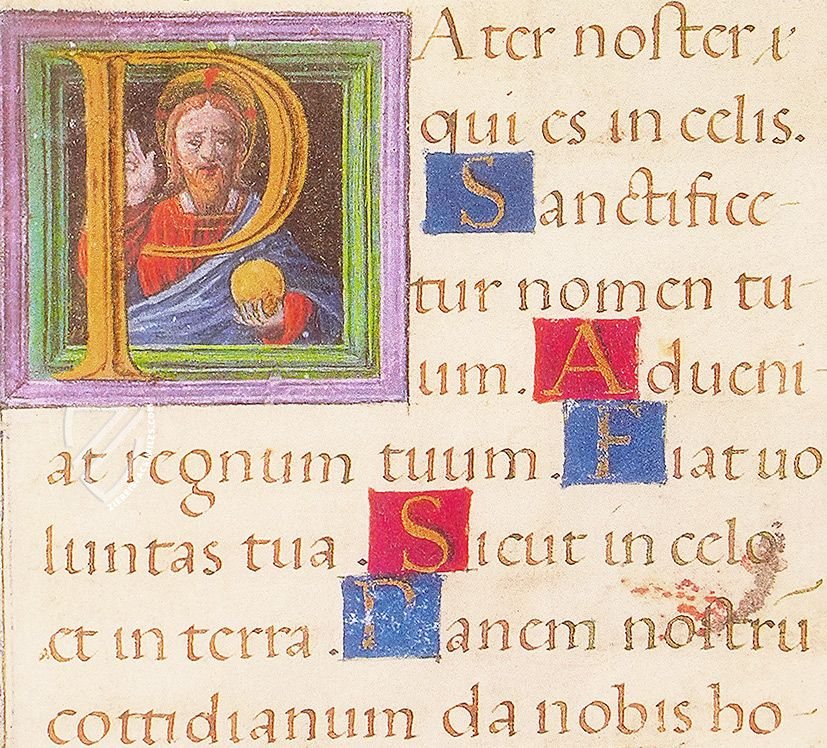
Liber Iesus and Treatise on Grammar by Donatus
Portrait of Maximilian Sforza
Ambrogio de Predis was the court painter to Ludovico Maria Sforza, il Moro, and was particularly renowned for his masterly portraits. No wonder, then, that he painted this full-page portrait of Maximilian on fol. 1v as the prelude to his primer. Interestingly, de Predis also worked at times as a court painter for Bianca Maria Sforza and her husband, Emperor Maximilian I, after whom Maximilian Sforza was named.
No more than six years old at the time of creation, Maximilian is shown in the traditional profile view - the typical mode of representation for portraits of rulers since antiquity. His soft, childlike facial features stand out against the deep black background, with which the boy's dark armor almost seems to merge. His red cap, however, which corresponds to the fashion of the time, stands out clearly and also overlaps the narrow golden frame of the picture.
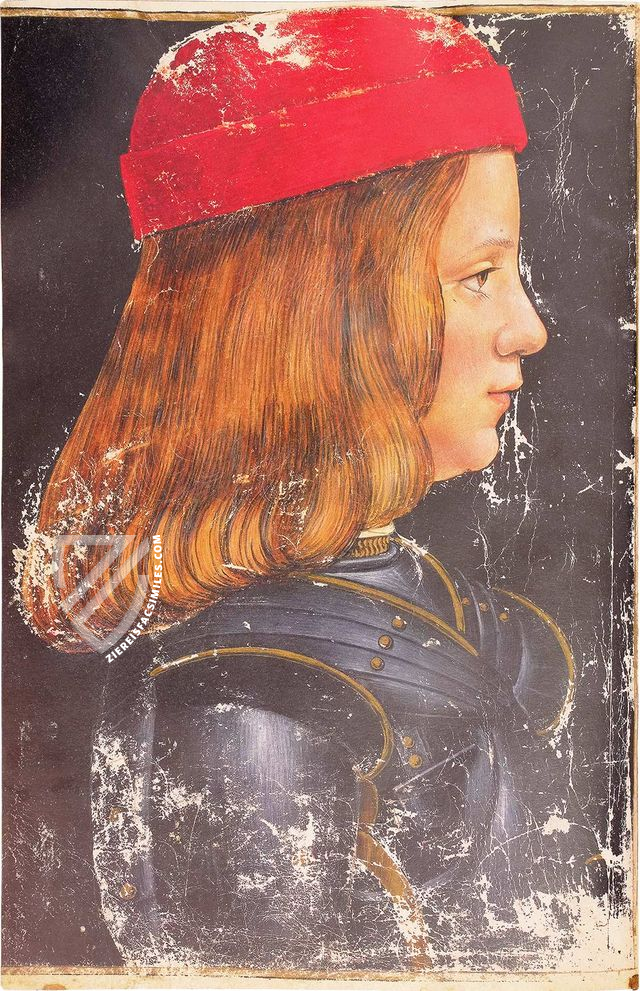
#1 Grammatica del Donato e Liber Iesus
Language: Italian
- Treatises / Secular Books
- Apocalypses / Beatus
- Astronomy / Astrology
- Bestiaries
- Bibles / Gospels
- Chronicles / History / Law
- Geography / Maps
- Saints' Lives
- Islam / Oriental
- Judaism / Hebrew
- Single Leaf Collections
- Leonardo da Vinci
- Literature / Poetry
- Liturgical Manuscripts
- Medicine / Botany / Alchemy
- Music
- Mythology / Prophecies
- Psalters
- Other Religious Books
- Games / Hunting
- Private Devotion Books
- Other Genres
- Afghanistan
- Armenia
- Austria
- Belgium
- Belize
- Bosnia and Herzegovina
- China
- Colombia
- Costa Rica
- Croatia
- Cyprus
- Czech Republic
- Denmark
- Egypt
- El Salvador
- Ethiopia
- France
- Germany
- Greece
- Guatemala
- Honduras
- Hungary
- India
- Iran
- Iraq
- Israel
- Italy
- Japan
- Jordan
- Kazakhstan
- Kyrgyzstan
- Lebanon
- Liechtenstein
- Luxembourg
- Mexico
- Morocco
- Netherlands
- Palestine
- Panama
- Peru
- Poland
- Portugal
- Romania
- Russia
- Serbia
- Spain
- Sri Lanka
- Sweden
- Switzerland
- Syria
- Tajikistan
- Turkey
- Turkmenistan
- Ukraine
- United Kingdom
- United States
- Uzbekistan
- Vatican City
- A. Oosthoek, van Holkema & Warendorf
- Aboca Museum
- Ajuntament de Valencia
- Akademie Verlag
- Akademische Druck- u. Verlagsanstalt (ADEVA)
- Aldo Ausilio Editore - Bottega d’Erasmo
- Alecto Historical Editions
- Alkuin Verlag
- Almqvist & Wiksell
- Amilcare Pizzi
- Andreas & Andreas Verlagsbuchhandlung
- Archa 90
- Archiv Verlag
- Archivi Edizioni
- Arnold Verlag
- ARS
- Ars Magna
- ArtCodex
- AyN Ediciones
- Azimuth Editions
- Badenia Verlag
- Bärenreiter-Verlag
- Belser Verlag
- Belser Verlag / WK Wertkontor
- Benziger Verlag
- Bernardinum Wydawnictwo
- BiblioGemma
- Biblioteca Apostolica Vaticana (Vaticanstadt, Vaticanstadt)
- Bibliotheca Palatina Faksimile Verlag
- Bibliotheca Rara
- Boydell & Brewer
- Bramante Edizioni
- Bredius Genootschap
- Brepols Publishers
- British Library
- C. Weckesser
- Caixa Catalunya
- Canesi
- CAPSA, Ars Scriptoria
- Caratzas Brothers, Publishers
- Carus Verlag
- Casamassima Libri
- Centrum Cartographie Verlag GmbH
- Chavane Verlag
- Christian Brandstätter Verlag
- Circulo Cientifico
- Club Bibliófilo Versol
- Club du Livre
- CM Editores
- Collegium Graphicum
- Collezione Apocrifa Da Vinci
- Comissão Nacional para as Comemorações dos Descobrimentos Portugueses
- Coron Verlag
- Corvina
- CTHS
- D. S. Brewer
- Damon
- De Agostini/UTET
- De Nederlandsche Boekhandel
- De Schutter
- Deuschle & Stemmle
- Deutscher Verlag für Kunstwissenschaft
- DIAMM
- Droz
- E. Schreiber Graphische Kunstanstalten
- Ediciones Boreal
- Ediciones Grial
- Ediclube
- Edições Inapa
- Edilan
- Editalia
- Edition Deuschle
- Edition Georg Popp
- Edition Leipzig
- Edition Libri Illustri
- Editiones Reales Sitios S. L.
- Éditions de l'Oiseau Lyre
- Editions Medicina Rara
- Editorial Casariego
- Editorial Mintzoa
- Editrice Antenore
- Editrice Velar
- Edizioni Edison
- Egeria, S.L.
- Eikon Editores
- Electa
- Emery Walker Limited
- Enciclopèdia Catalana
- Eos-Verlag
- Ephesus Publishing
- Ernst Battenberg
- Eugrammia Press
- Extraordinary Editions
- Fackelverlag
- Facsimila Art & Edition
- Facsimile Editions Ltd.
- Facsimilia Art & Edition Ebert KG
- Faksimile Verlag
- Feuermann Verlag
- Folger Shakespeare Library
- Franco Cosimo Panini Editore
- Friedrich Wittig Verlag
- Fundación Hullera Vasco-Leonesa
- G. Braziller
- Gabriele Mazzotta Editore
- Gebr. Mann Verlag
- Gesellschaft für graphische Industrie
- Getty Research Institute
- Giovanni Domenico de Rossi
- Giunti Editore
- Graffiti
- Grafica European Center of Fine Arts
- Guido Pressler
- Guillermo Blazquez
- Gustav Kiepenheuer
- H. N. Abrams
- Harrassowitz
- Harvard University Press
- Helikon
- Hendrickson Publishers
- Henning Oppermann
- Herder Verlag
- Hes & De Graaf Publishers
- Hoepli
- Holbein-Verlag
- Houghton Library
- Hugo Schmidt Verlag
- Idion Verlag
- Il Bulino, edizioni d'arte
- ILte
- Imago
- Insel Verlag
- Insel-Verlag Anton Kippenberger
- Instituto de Estudios Altoaragoneses
- Instituto Nacional de Antropología e Historia
- Istituto dell'Enciclopedia Italiana - Treccani
- Istituto Ellenico di Studi Bizantini e Postbizantini
- Istituto Geografico De Agostini
- Istituto Poligrafico e Zecca dello Stato
- Italarte Art Establishments
- Jan Thorbecke Verlag
- Johnson Reprint Corporation
- Josef Stocker
- Josef Stocker-Schmid
- Jugoslavija
- Karl W. Hiersemann
- Kasper Straube
- Kaydeda Ediciones
- Kindler Verlag / Coron Verlag
- Kodansha International Ltd.
- Konrad Kölbl Verlag
- Kurt Wolff Verlag
- La Liberia dello Stato
- La Linea Editrice
- La Meta Editore
- Lambert Schneider
- Landeskreditbank Baden-Württemberg
- Leo S. Olschki
- Les Incunables
- Liber Artis
- Library of Congress
- Libreria Musicale Italiana
- Lichtdruck
- Lito Immagine Editore
- Lumen Artis
- Lund Humphries
- M. Moleiro Editor
- Maison des Sciences de l'homme et de la société de Poitiers
- Manuscriptum
- Martinus Nijhoff
- Maruzen-Yushodo Co. Ltd.
- MASA
- Massada Publishers
- McGraw-Hill
- Metropolitan Museum of Art
- Militos
- Millennium Liber
- Müller & Schindler
- Nahar - Stavit
- Nahar and Steimatzky
- National Library of Wales
- Neri Pozza
- Nova Charta
- Oceanum Verlag
- Odeon
- Orbis Mediaevalis
- Orbis Pictus
- Österreichische Staatsdruckerei
- Oxford University Press
- Pageant Books
- Parzellers Buchverlag
- Patrimonio Ediciones
- Pattloch Verlag
- PIAF
- Pieper Verlag
- Plon-Nourrit et cie
- Poligrafiche Bolis
- Presses Universitaires de Strasbourg
- Prestel Verlag
- Princeton University Press
- Prisma Verlag
- Priuli & Verlucca, editori
- Pro Sport Verlag
- Propyläen Verlag
- Pytheas Books
- Quaternio Verlag Luzern
- Reales Sitios
- Recht-Verlag
- Reichert Verlag
- Reichsdruckerei
- Reprint Verlag
- Riehn & Reusch
- Roberto Vattori Editore
- Rosenkilde and Bagger
- Roxburghe Club
- Salerno Editrice
- Saltellus Press
- Sandoz
- Sarajevo Svjetlost
- Schöck ArtPrint Kft.
- Schulsinger Brothers
- Scolar Press
- Scrinium
- Scripta Maneant
- Scriptorium
- Shazar
- Siloé, arte y bibliofilia
- SISMEL - Edizioni del Galluzzo
- Sociedad Mexicana de Antropología
- Société des Bibliophiles & Iconophiles de Belgique
- Soncin Publishing
- Sorli Ediciones
- Stainer and Bell
- Studer
- Styria Verlag
- Sumptibus Pragopress
- Szegedi Tudomànyegyetem
- Taberna Libraria
- Tarshish Books
- Taschen
- Tempus Libri
- Testimonio Compañía Editorial
- Thames and Hudson
- The Clear Vue Publishing Partnership Limited
- The Facsimile Codex
- The Folio Society
- The Marquess of Normanby
- The Richard III and Yorkist History Trust
- Tip.Le.Co
- TouchArt
- TREC Publishing House
- TRI Publishing Co.
- Trident Editore
- Tuliba Collection
- Typis Regiae Officinae Polygraphicae
- Union Verlag Berlin
- Universidad de Granada
- University of California Press
- University of Chicago Press
- Urs Graf
- Vallecchi
- Van Wijnen
- VCH, Acta Humaniora
- VDI Verlag
- VEB Deutscher Verlag für Musik
- Verlag Anton Pustet / Andreas Verlag
- Verlag Bibliophile Drucke Josef Stocker
- Verlag der Münchner Drucke
- Verlag für Regionalgeschichte
- Verlag Styria
- Vicent Garcia Editores
- W. Turnowski Ltd.
- W. Turnowsky
- Waanders Printers
- Wiener Mechitharisten-Congregation (Wien, Österreich)
- Wissenschaftliche Buchgesellschaft
- Wissenschaftliche Verlagsgesellschaft
- Wydawnictwo Dolnoslaskie
- Xuntanza Editorial
- Zakład Narodowy
- Zollikofer AG

